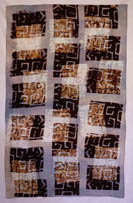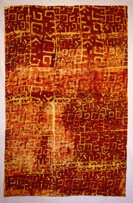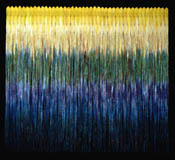|

DIALOGUE WITH AFRICAN
PATTERNS, KUBA SERIES #1
2003
58"x36"
dye -printed, painted and removed
$400

DIALOGUE WITH AFRICAN
PATTERNS, KUBA SERIES #4
2003
56"x36"
dye- printed, painted and removed
$400

DIALOGUE WITH AFRICAN
PATTERNS, KUBA SERIES #4, detail

LIGHT #2
2001
68"x76"
dyed cotton and linen, woven
|
BIOGRAPHICAL INFORMATION
|
| |
Current Position
Professor of Art, San Francisco State University, 1974-
|
Education
| |
1994
|
Doctoral Equivalency, SFSU
| |
1970
|
MA, Art (design and textiles), San Jose State University, San Jose, CA
| |
1991
|
BA, Art (drawing and painting), Portland State University, Portland, OR
|
Publications
| |
1994
|
Weben Mit Brettchen, Haupt Press, Struttgart, Germany (German translation
of Card Weaving)
| |
1991
|
Card Weaving, Interweave Press (revised and expanded edition)
| |
1977
|
The Complete Spinning Book, Watson-Guptill Publications
|
Other/Professional
| |
1997
|
Principal curator: The Fabric of Life: 150 Years of Fiber Art History
In Northern California, SFSU Art Department Gallery, San Francisco, CA
|
Selected Collections/Commissions
|
Hyatt Regency, San Francisco
Temple Beth Jacob (Torah Curtain), Redwood City, CA
Thelen, Marin, Johnson, and Bridges, San Francisco
Bonaventure Hotel, Los Angeles
Crocker Bank, Pebble Beach, CA
Oakland Museum
|
ARTIST STATEMENT
Card weaving, also called tablet weaving, is a technique I have worked
with for many years. The process involves 4"x4" square cards
with holes in the center through which threads are pulled. As the cards
rotate, different threads come to the top and a weaving shed is created.
This deceptively simple setup can produce complex woven structures and
patterns. The rotation of the cards also causes the warp threads to
twist, which reflects light and causes the fabric to undulate.
In my most recent work, dyeing has become a major part of the visual
statement. I begin with different neutral yarns, prepare warps, then
use indigo and fiber reactive dyes to color each thread. After the dyeing
is complete, I thread the cards. Each band is woven separately. Light
#2 consists of 43 doubled bands for a total of 86 individual sections.
The complexity that comes from color, weave structure, and pattern
changing from band to band, builds a whole that reminds me of light
playing on a landscape at different times of the day.
I have been studying Kuba patterns for many years and have a small
collection of traditional older fabrics from this area. The Kuba are
part of the African country that has been called Zaire, the Congo, and
the Republic of Congo. The patterned images of the Kuba incorporate
simple geometrical shapes in a variety of repeats. The textiles are
embroidered with raffia on a woven raffia ground. I am fascinated by
how these images build, interact, and multiply. There is a spontaneous
and improvisational quality to how the pattern develops and covers the
raffia fabric. I took elements of their patterns and their overall concept
of pattern variation and worked with these ideas in my own way. I used
a completely different fabric, a very fine, transparent, white silk
and printed my images rather than embroidered. I built my patterns by
manipulating the fabric, cutting up images, and by layering the repeats
through printed and painted dye, and by adding and subtracting color.
COMMENTS ON THE
FIBER FIELD
I am drawn to and fascinated by all aspects of textiles. I have learned
about history, other cultures, design, and myself, by studying and working
with textiles. The processes of spinning, dyeing and weaving continue
to bring me joy and satisfaction. I believe the fiber field has many
facets, is ancient, and is anchored to our most intimate life.
|


